
Ukraine
For a full scale picture, please click on the picture shown !
Passenger trains

Much of Ukrainian railways still in 2017 looks like if it were a Soviet Russian railroad, with the exeption of some extremely modern
new trains. The Ukrainian state railways, Ukrzaliznytsia, has a total track length of over 21 600 km and serving 1447 stations, making
it the 14th largest railroad system of the world. It is also the world's 6th largest passenger transporter. Yet very little of
Ukrainian railroads is known in the western world.
This brand new train has nothing to do with the old socialist times. This is a class DPKr 2 brand new train of the manufacturer
KVSZ. This is a prototype diesel multiple unit first shown in 2014, intended for commuter or regional services. This three car train
has 269 seats and a top speed of 140 km/h. There is also a two car version. This is the prototype train no. 001. These are now offered
not only to Ukrainian railways, but also to other states in far east and ex-Soviet Union. This picture is an absolute rarity.
Picture at Pidzamche by Lviv by Juha Mannila in May 2017.

The same class DPKr 2 prototype train no.001 at Lviv station.
Picture 26.9.2018 by Marek Graff.

This is the other one of the most modern trains of Ukraine, the HRCS2. These trains are built by Huyndai Rotem. They are referred to in Ukraine as
Intercity and Intercity+. They were ordered by Ukrainian Railways in preparation for the football championship UEFA Euro 2012 to
transport passengers between cities that would host sporting events. There was such a hurry that there was no possibility to test the trains
during the very cold Ukrainian winters and in December 2012 the trains broke down on a daily basis. Finally Hyundai Rotem had to
apologise to the Ukrainian president and Hyundai set up a permanent task force until 2018 to service the trains and fix the problems.
Now the manufacturer guarantees continuous operation of the trains.
Hyundai Rotem calls these ICR trains. There are 9 coaches per train set. They are used on the Kiev – Dnipropetrovsk – Zaporizhia,
Kiev – Kharkiv and Kiev – Lviv – Truskavets services. Top speed is 176 km/h and they can operate both on the old fashioned 3kV DC as well
as the more modern 25 kV AC tracks.
Picture at Pidzamche by Lviv by Juha Mannila in May 2017. Here again the lucky photographer has managed to picture the train no. 001.
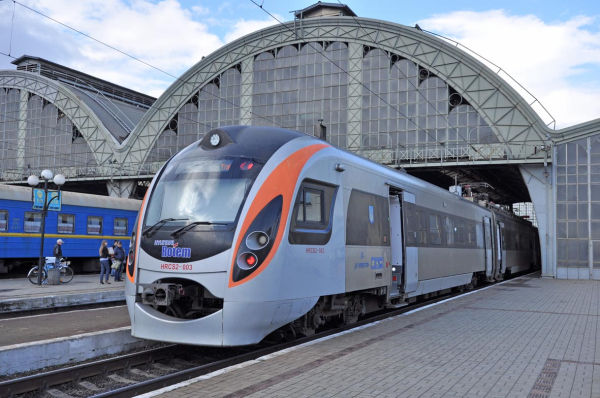
Another one of the new Huyndai Rotem trains, the no.003 having just arrived at the Lviv station.
Picture 24.9.2018 by Marek Graff.
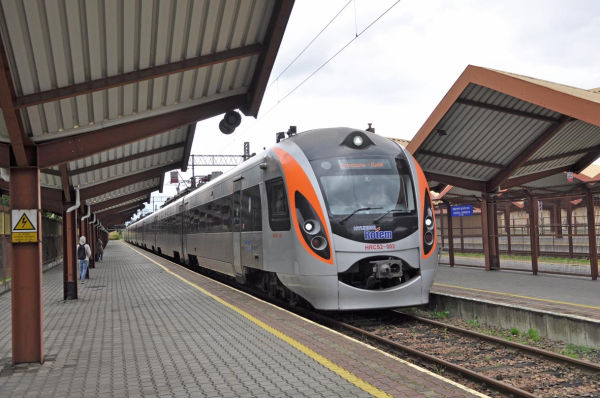
This is the same Huyndai Rotem HRCS 2 train no.003 as in the picture above, but here it has just arrived as a cross-border Intercity+
service to the Polish station of Przemyśl.
Picture 24.9.2018 by Marek Graff.

One of the Huyndai Rotem HRCS 2 trains, no.007 just having arrived from Poland to the Kiev main station.
Picture 28.4.2019 by Markku Salo.
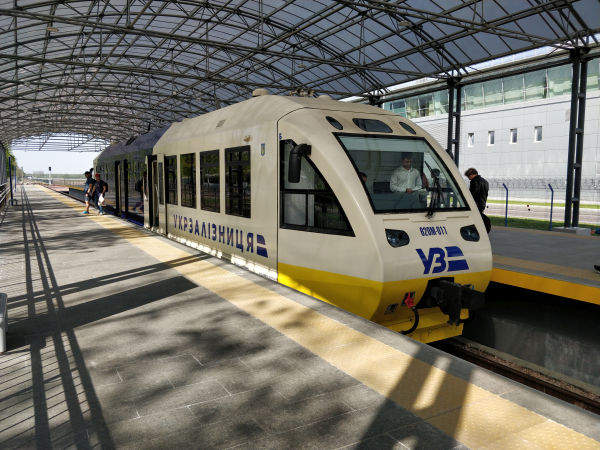
This is the "Kyiv - Boryspil Express" train which operates a fast connection between Kiev city and the Boryspil international airport.
The railbus type 620M is buiilt by the Polish company Pesa. They have MAN or MTU engines and their top speed is 120 km/h. Similar trains
are used as airport trains also in Lithuania.
Picture from the Boryspil airport train station 27.4.2019 by Markku Salo.
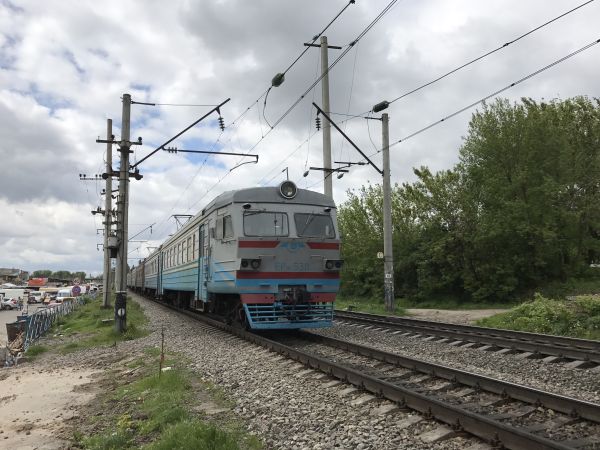
This regional train of the class ER9M is a product of the that time Soviet Latvia, built by RVR, Rīgas Vagonbūves Rūpnīca in Riga,
Latvia since 1976. It is a further modification of a 1960s design with some better features such as soft instead of wooden chairs for the
passengers. It is built for the 25kV AC electric system.
Picture from the Dvoretskaya train stop near Rivne in May 2017 by Juha Mannila.
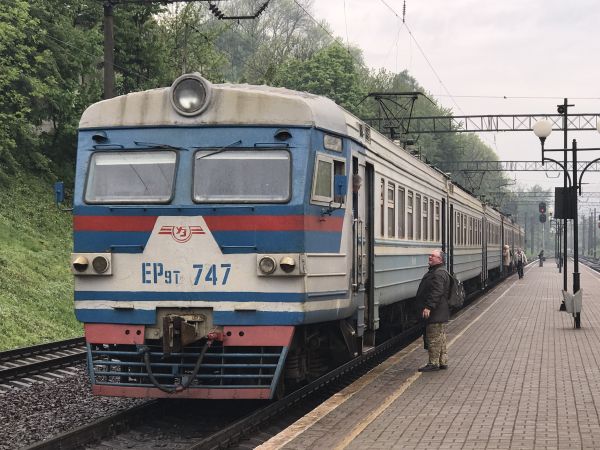
A class DR9T regional electric multiple unit. Also these units are products of RVR in Riga, Latvia. This is a further developed
train based on the Baltic railways ER2, but created for 25 kV AC services. The ER9T model was produced since 1988 till the end of
ER9 manufacturing by the plant in Riga. This modification has modernized bogies, traction engines and rheostatic brakes.
In western Europe "low floor" is such a "must" nowadays, but apparently in Ukraine it is still not much of an issue as long as the trains
otherwise are OK.
Picture from the Pidzamche by Lviv station in May 2017 by Juha Mannila.
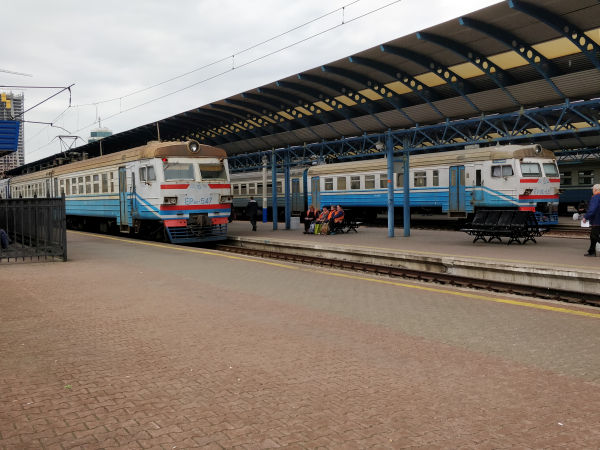
Most of the short haul or regional passenger train traffic in Ukraine is still today operated by these Soviet time trains from the 1960s.
On the left is an ER9M, on the right an almost similar ER9S.
Picture from Kiev main station 28.4.2019 by Markku Salo.

Some of the Ukrainian regional trains are quite long. This ten coach ER9E unit is photographed at Odessa.
Picture from the Odessa-Holovna station 29.4.2019 by Markku Salo.
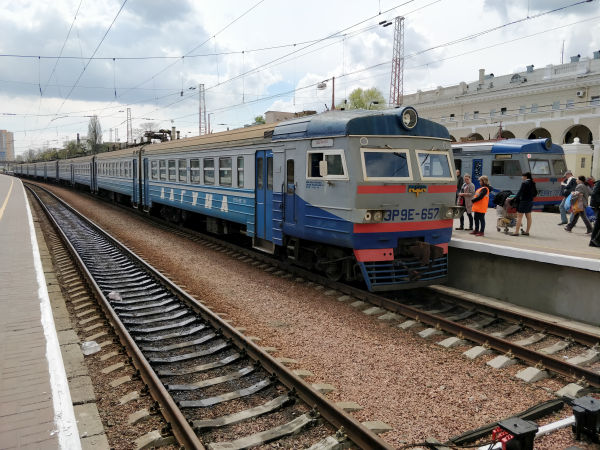
Another extremely long ER9E unit in Odessa.
Picture from the Odessa-Holovna station 29.4.2019 by Markku Salo.
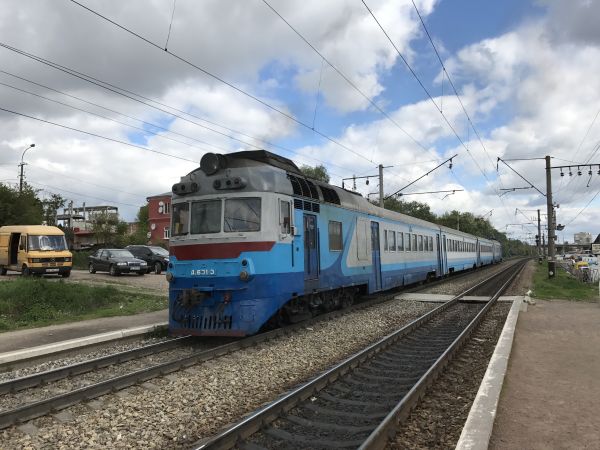
This is something that since 2010 would not be in service in the Baltic area any more. It is an old Soviet Union style diesel multiple
unit of the type D1. It is a product of the Hungarian company Ganz-MAVAG and it was built 1960s through 1980s. In most of the still
operating trains the original diesel engines have now been swapped to Swedish Volvo Penta ship engines, but in those cases the modernised
units are designated as D1M. This one is still one of the original ones without any modernisation. Picture from the Dvoretskaya train
stop near Rivne in May 2017 by Juha Mannila.
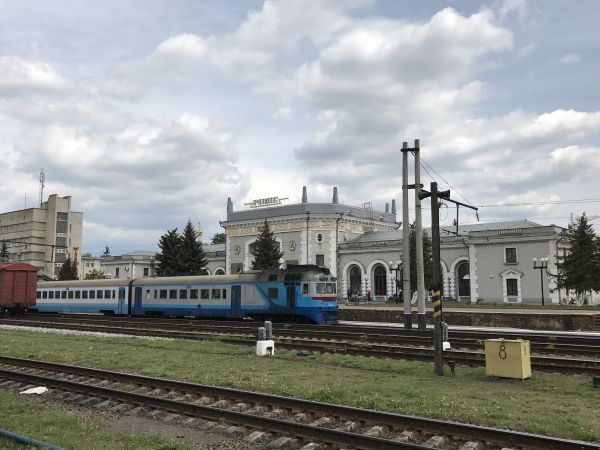
Another class D1 unit at the station of Rivne. Picture in May 2017 by Juha Mannila.
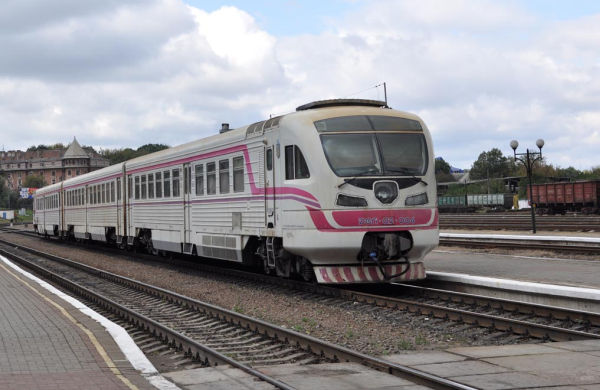
This pecular looking diesel multiple unit for regional traffic is of the type DEL-02 built by the Luhanskteplovoz factory in
what now is Russian occupied area of eastern Ukraine. The modern looking nose is a glass fiber construction built by the factory
R&D enterprise ROST. It is an independent module including all the electronics needed for steering the train which can be "glued"
at the front of the train. This model is from 2004. It has 336 seats. Top speed is 130 km/h.
Picture from Chernivtsy station 25.9.2018 by Marek Graff.

A class ChS2 electric locomotive is waiting for a shunter to bring its rake of passenger wagons. The type ChS2 was built by Škoda
Works in what then was Chechoslovakia 1958 to 1976. Over 1000 locomotives were built in two variants for the Russian broad gauge.
The type is also common on normal gauge especially in the Czech republic, Slovakia and Poland. This type works only with 3 kV DC.
Top speed is 160 km/h. This broad gauge variant is only in use in Russia and Ukraine now.
Picture from Lviv station 26.9.2018 by Marek Graff.

Some of the later machines of the same type ChS2 got a more modern look although internally the machine remained the same.
Picture of ChS2 number 581 at Lviv station 26.9.2018 by Marek Graff.
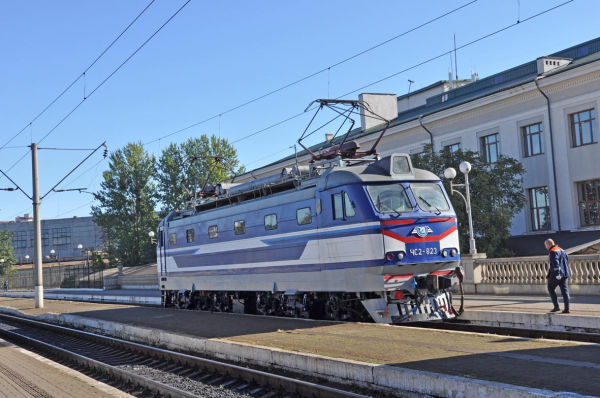
The ChS2 number 823 looks very modern, although it is already from the 1970s.
Picture of ChS2 number 823 at Lviv station 26.9.2018 by Marek Graff.
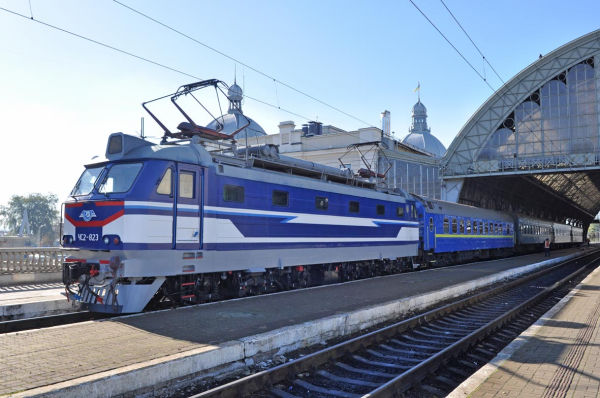
Freshly renovated and repainted, the ChS2 no.823 looks brand new in front of its express train.
Picture of ChS2 number 823 at Lviv station 26.9.2018 by Marek Graff.
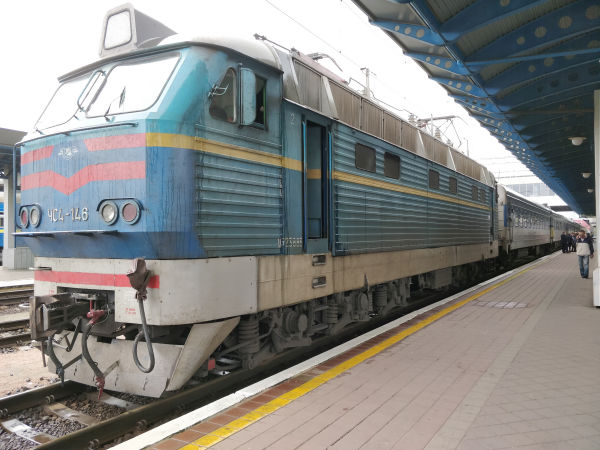
The ChS4 locomotive type was built by Škoda in what then was Czechoslovakia 1969-72. Like many other Škoda locomotives, they had a
ronded front part. The machines were never a success and finally they have now all been thorougly rebuilt in Ukraine. Even a large
part of their metal chassis was reconstructed and now the machines do not any more much resemble the original ChS4. The type was
built for fast passenger trains on 25 kV AC Russian broad gauge lines. It had a power rating of 5100 kW and a maximum speed of 160 km/h.
They are used in Russia, Belarus and Ukraine.
Picture from Kiev main station 28.4.2019 by Markku Salo.
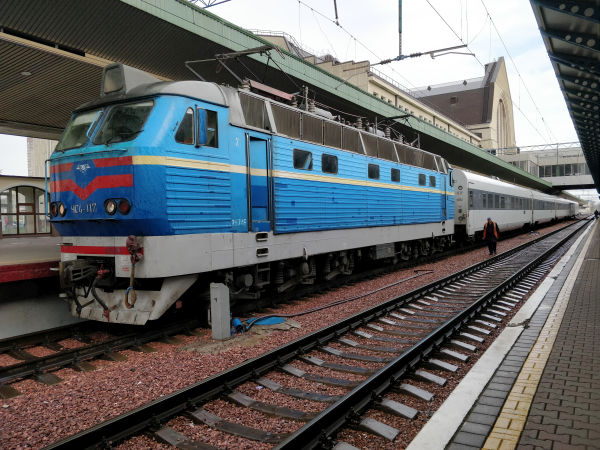
Another similar ChS4 Škoda locomotive just ready to leave Kiev.
Picture from Kiev main station 28.4.2019 by Markku Salo.
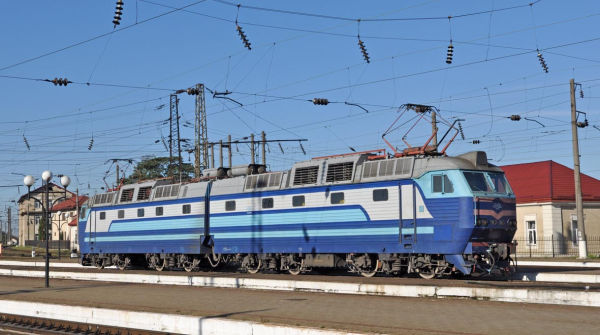
The class ChS7 double locomotive is one of the strongest locomotives in use in Russia and Ukraine. They were built 1983 to 1999
by Škoda Works in Plzen, Czech Republic. A total of 321 machines were built and they were designed for heavy passenger trains
of up to 32 coaches especially in Siberia. They are only in use in Russia and Ukraine today. The power rating of this locomotive
is 8400 kW and the top speed is 160 km/h.
Picture from Lviv station 26.9.2018 by Marek Graff.

Class ChS8 is a further development of the ChS7 shown above. It's a 25 kV AC machine designed to be able to pull 28 to 32 coaches
long passenger trains at at least 100 km/h or faster. Top speed is 180 km/h. In 1983 the first two prototypes were built and sent to
Kiev for testing. Then a "mass prototype" series of 30 locomotives followed and finally 50 more were made. The power rating of this
machine is 7200 kW. The type is only to be found in Ukraine and Russia. This one, no.029 is one of the "mass prototype" series
machines.
Picture from Lviv station 26.9.2018 by Marek Graff.
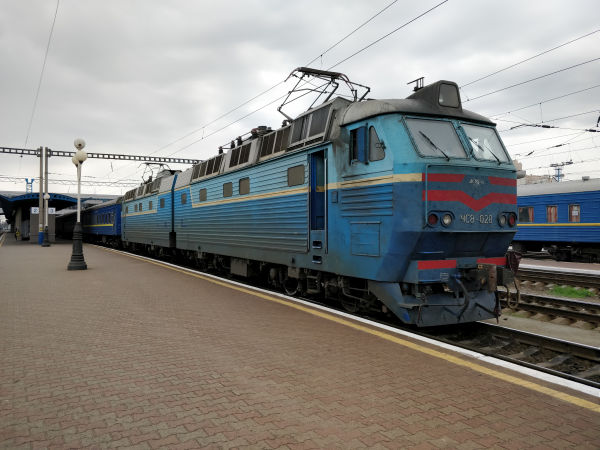
Another double locomotive of the class ChS8, this no.028 also belongs to the so called mass prototype first series.
Picture from Kiev main station 28.4.2019 by Markku Salo.
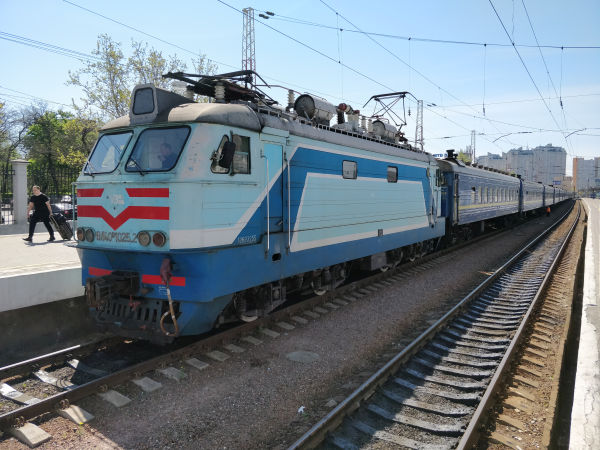
The locomotive type VL40 was built by the Novotserkassk locomotive works in the 1970s. It was an export model made for Finland
where the type is called Sr1. Novotserkask normally built only double locomotives and the VL40/Sr1 was in many ways special
for them. This Ukrainian VL40U looks a bit different from its counterpart in Finland. Click
here to
see a picture of the Sr1 in its original paintings in Finland. (Picture behind the link by Mikko Nyman.)
The VL40U is actually one half of a VL80 which has received a new cab at both ends. They are used in Ukraine and Kazachstan.
This picture on the left is from the Odessa-Holovna station in Ukraine 29.4.2019 by Markku Salo.

The same VL40U as above, seen from the other side.
Picture from the Odessa-Holovna station in Ukraine 29.4.2019 by Markku Salo.
Children's railroad "Partisanska" in Rivne
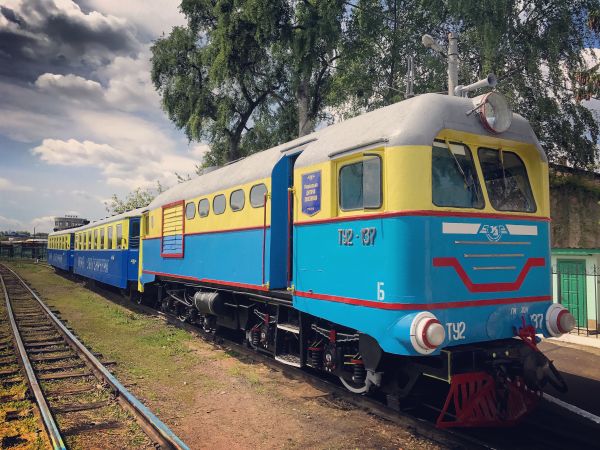
During socialist times not only the Soviet Union, but also many of the other socialist countries were full of so called pioneer
camps and pioneer railroads. The pioneer railroads were typically short narrow gauge railroads, where children of various ages
would operate the trains. The original reasoning was that it was these countries preparation for war: While all the adults would
be on the front fighting, the youngsters would have the necessary skills to operate trains. Now after the socialist times are
long gone, the word pioneer railways is typically not anymore used, but many of these small training railroads still operate and
are called children's railroads. And the children love to operate trains.
This picture is from the children's railroad "Partisanska" in Rivne. The locomotive is a class TU2 750 mm narrow gauge diesel
engine from the early 1960s. The TU2's were very common machines throughout the former Soviet Union's narrow gauge railroads and
some of them are still in use. For more pictures of TU2 locomotives, see for example the section Latvia -> Aluksne-Gulbene narrow
gauge railway in this same picture archive.
Picture in Rivne in May 2017 by Juha Mannila.
Stations
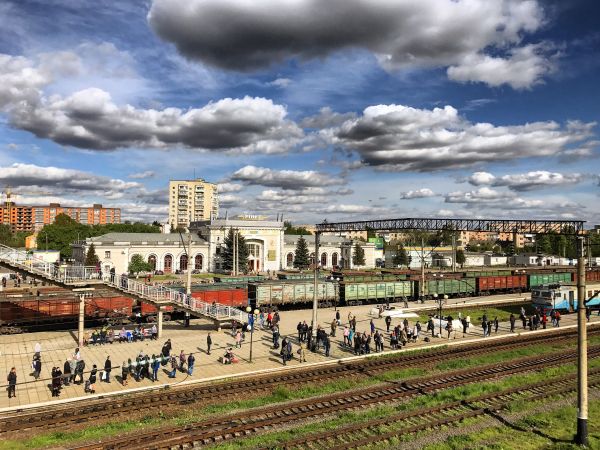
A typical large Ukrainian station, the station of Rivne.
Picture in Rivne in May 2017 by Juha Mannila.
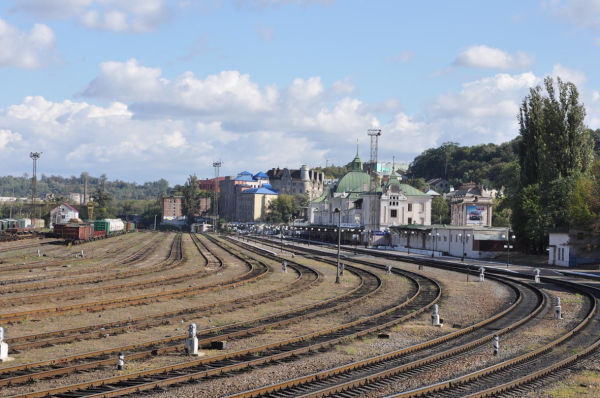
The station of Chernivtsy in western Ukraine.
Picture 25.9.2018 by Marek Graff.
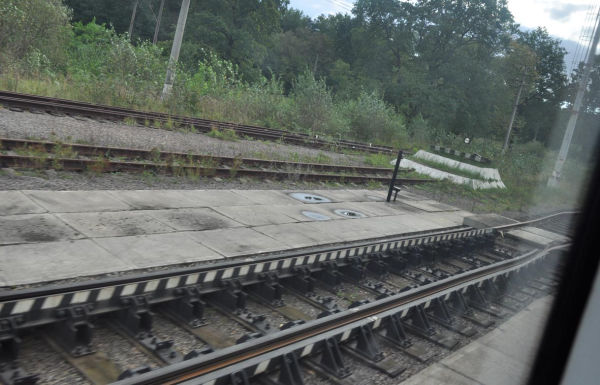
The station Mostyska II lies along the old Galician railway from Kraków in Poland to Lviv in Ukraine. During Soviet rule the Ukrainian
side of the line was regauged to Russian broad gauge and in 1950 at the station Mostyska II close to the Polish-Ukrainian border a track
gauge changing facility was installed. This is the new SUW-2000 gauge changing facilty where trains with the SUW-2000 variable gauge
axles can slowly roll by and their axles are adjusted to the new gauge.
Picture from Mostyska II 24.9.2018 by Marek Graff.
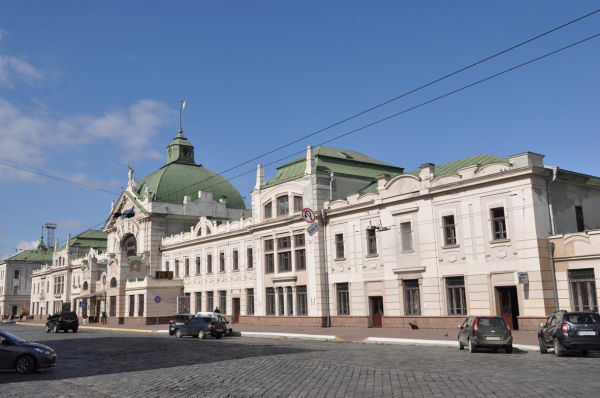
The station of Chernivtsy seen from the other side.
Picture 25.9.2018 by Marek Graff.
Ukrainian cargo trains and locomotives
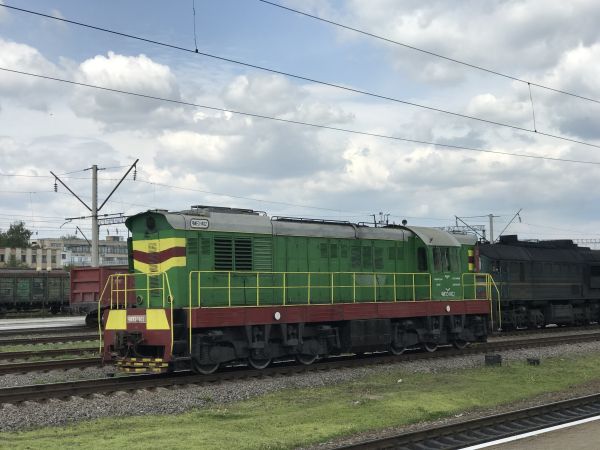
The class ChME3 heavy shunter locomotives are a common sight throughout the former Soviet Union. This one is in particularly
good condition. They were built by the company ČKD (Českomoravská Kolben-Daněk) in Czechoslovakia. The design is a modified
copy of a pre-WW II US design. They were built during a long period, 1963-1984 in a stunning 8200 copies. The machine weighs
126 tons and it has a maximum speed of 95 km/h.
Picture in Rivne in May 2017 by Juha Mannila.

Another class ChME3 shunter just passing the train stop of Pidzamche by Lviv. Picture in May 2017 by Juha Mannila.
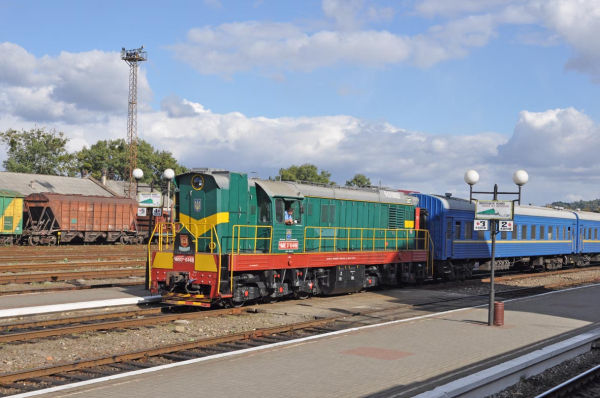
A ChME3 shunter, number 6448, in a very shining and prime condition is bringing an express train wagon set to the station of
Chernivtsy.
Picture 25.9.2018 by Marek Graff.
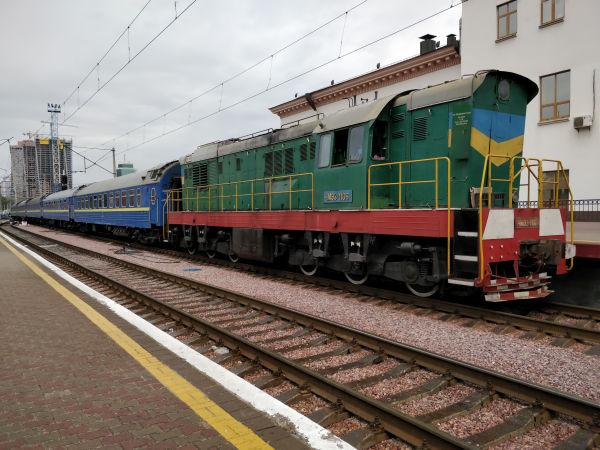
Another ChME3 shunter brings a rake of express train coaches into the Kiev main station.
Picture 28.4.2019 by Markku Salo.
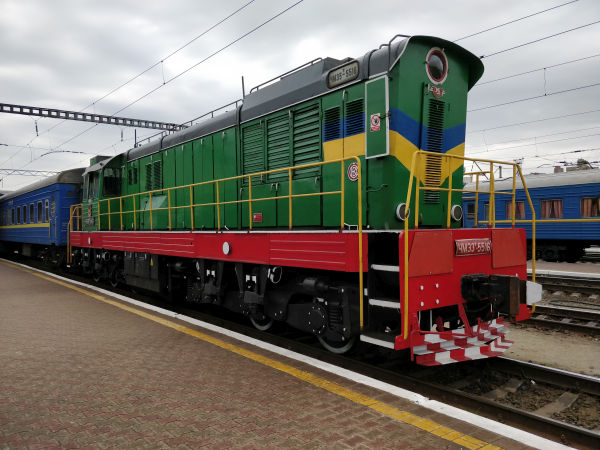
A freshly modernised and repainted ChME3T shunter is bringing a rake of passenger coaches to the Kiev main station platform.
Picture from Kiev 28.4.2019 by Markku Salo.
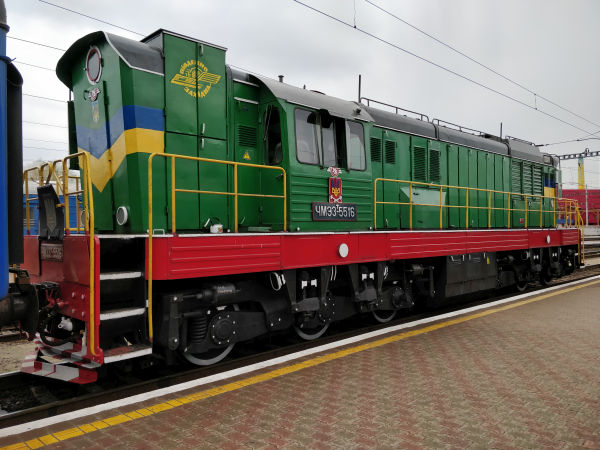
The same ChME3T locomotive as above, but seen from the other side. ChME3T is a newer version of the widespread ChME3. The main difference
is that the T model has a rheostatic brake. The first ChME3T locomotives were built in 1984.
Picture from Kiev 28.4.2019 by Markku Salo.
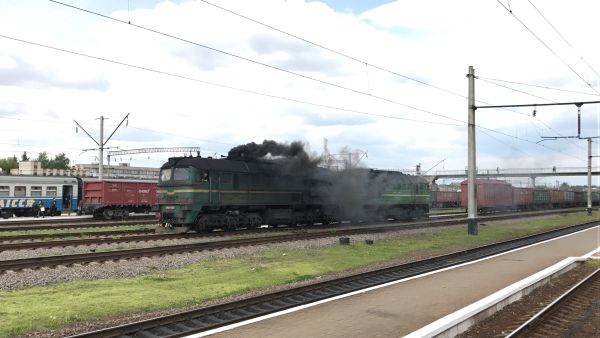
A class 2M62 double diesel locomotive. The model M62 was a product of the locomotive works of Luhansk, eastern Ukraine, of the
early 1960s. It was intended as an export model to those socialist block countries with western loading gauge trains. Technically
it was based on the 1950s design TE10. They were exported to many countries from Eastern Germany in the west to China and North
Korea in the east. The name M62 (model 62) actually comes from the Hungarian railways naming system. In addition to the normal M62's,
also double locomotive versions 2M62 (two units with just one driver's cab each) and 3M62 (three units, with the middle one without
cabs) were produced. The M62s have been notorious for their thirst of diesel fuel and they have always been very smokey. But this
individual seems to smoke more than an average steam engine.
Picture in Rivne in May 2017 by Juha Mannila.

A class 2M62U double locomotive passing the train stop Dvoretskaya by Lviv. The version U is a bit more modern than the basic
2M62. The U versions were built 1989-1990. Picture at Dvoretskaya in May 2017 by Juha Mannila.
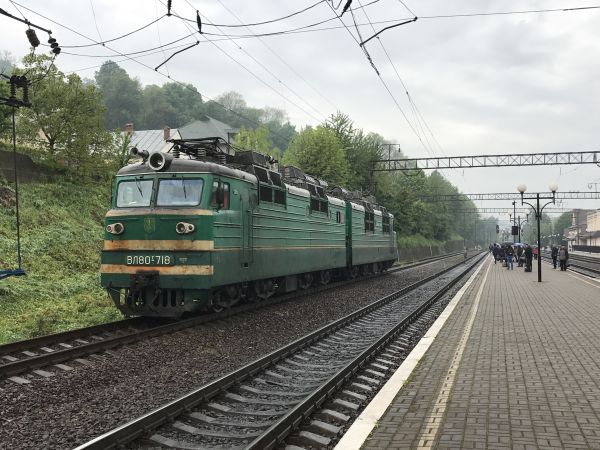
A class VL80T double electric locomotive. (VL stands for Vladimir Lenin.) The type was designed by the "All-Russian scientific
research and design-engineering institute of electric locomotive construction ВЭлНИИ" and was in production in different variants
1961-1999, a stunning 33 years. They were built by the Novocherkassk Electric Locomotive Plant NEVZ. It operates under 25 kV AC
and has a power rating of 6400 kW and a top speed of 110 km/h. The model is in use in Russia, Kazahstan, Ukraine, Belarus and
Uzbekistan and has been in use both for cargo and passenger traffic. Picture at Pidzamche by Lviv in May 2017 by Juha Mannila.

Another class VL80T double electric locomotive with a heavy crude oil train passing the train stop of Dvoretskaya close to Rivne.
Picture in May 2017 by Juha Mannila.

A VL80 subtype K locomotive pulling a heavy cargo train passing the train stop Dvoretskaya by Lviv. This type VL80K is older than the
subtype T pictured above. The VL80T (ru: ВЛ80T) introduced a markedly different electrical system, as well as an improved lateral
support system which improved the locomotive's stability. Originally, the series used spring suspension similar to that found in the
older VL80K, but all models built since 1971 have cradle suspension.
Picture of a VL80K at Dvoretskaya in May 2017 by Juha Mannila.
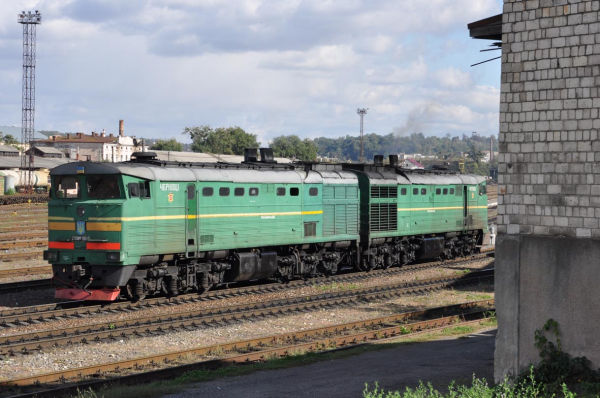
A class 2TE10 number 2601 double locomotive. The type 2TE10 was in production as a Soviet-Ukrainian machine since 1960 at the Luhanskteplovoz
and Malyshev factories in Ukraine. This one is from the very first seroes built 1960 to 1963. Only 19 locomotives were made in this very first
series. It's a twelve axle mammoth with a top speed of 100 km/h. The 2TE10s in various subtypes are still in use in Russia, Ukraine, Belarus
and Latvia.
Picture from Chernivtsy station 25.9.2018 by Marek Graff.
Trams
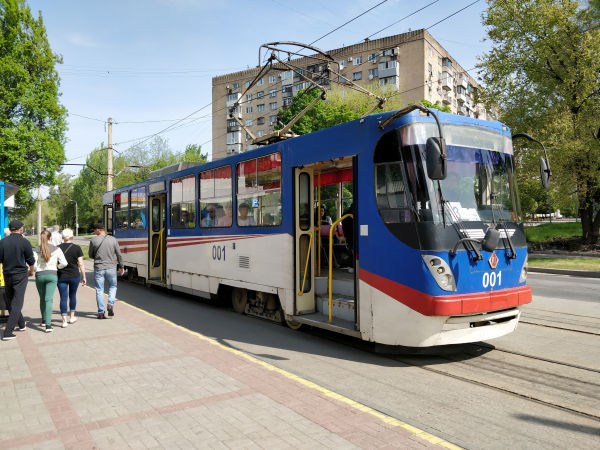
City of Zaporizhzya tram no.001. It looks like a broad gauge Czech made Tatra tram from the 1970s, which has received a new front, but
who knows?
Picture from Patriotychna street in Zaporizhzya 29.4.2019 by Markku Salo.
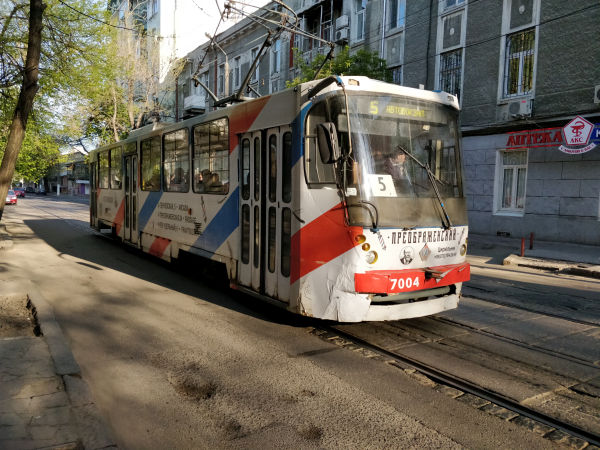
City of Odessa tram no.7004 looks quite similar to the one pictured above.
Picture from Panteleimonivska street in Odessa 29.4.2019 by Markku Salo.
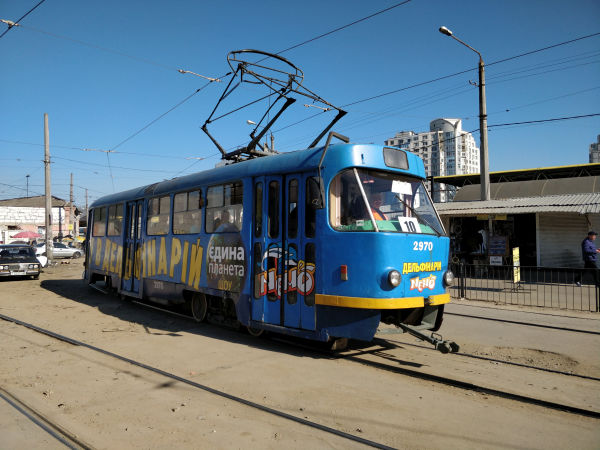
City of Odessa tram no.2970 is a Czech made Tatra T3SU. That model was produced during a very long time, 1962-1997. This one is of
the subtype SU (for Soviet Union), that proves the fact that the driver sits in an isolated cabinet. And this must be one of the later T3SU
wagons, since the early SU-models had no middle doors.
Picture from near the Odessa zoo 29.4.2019 by Markku Salo.
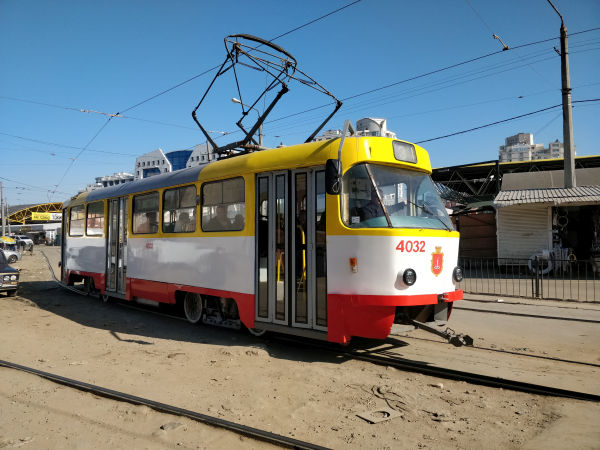
Odessa tram no.4032 is also a Czech made Tatra T3SU, but one which has been freshly modernised: new doors, new furniture, new LED lamps
etc - but surprisingly still no sign of an air conditioning machine on the roof.
Picture from near the Odessa zoo 29.4.2019 by Markku Salo.
Miscellaneous
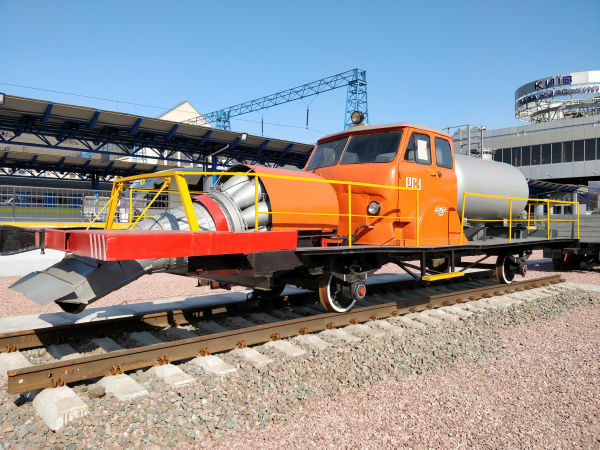
This very peculiar wagon named RS-1 is a construction for melting and blowing away of ice and snow from tracks and points. The blower is an old
jet engine from a military plane and the cab has been taken from an old truck. This same idea was already used in Britain right after the second
world war.
Picture from the Museum of Railway Transport by the Kiev main station 27.4.2019 by Markku Salo.

